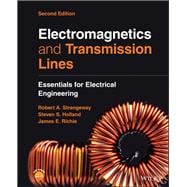Textbook resource covering static electric and magnetic fields, dynamic electromagnetic fields, transmission lines, antennas, and signal integrity within a single course
Electromagnetics and Transmission Lines provides coverage of what every electrical engineer (not just the electromagnetic specialist) should know about electromagnetic fields and transmission lines. This work examines several fundamental electrical engineering concepts and components from an electromagnetic fields viewpoint, such as electric circuit laws, resistance, capacitance, and self and mutual inductances. The approach to transmission lines (T-lines), Smith charts, and scattering parameters establishes the underlying concepts of vector network analyzer (VNA) measurements. System-level antenna parameters, basic wireless links, and signal integrity are examined in the final chapters.
As an efficient learning resource, electromagnetics and transmission lines content is strategically modulated in breadth and depth towards a single semester objective. Extraneous, distracting topics are excluded. The wording style is somewhat more conversational than most electromagnetics textbooks in order to enhance student engagement and inclusivity while conveying the rigor that is essential for engineering student development. To aid in information retention, the authors also provide supplementary material, including a homework solutions manual, lecture notes, and VNA experiments.
Sample topics covered in Electromagnetics and Transmission Lines include:
- Vector algebra and coordinate systems, Coulomb’s law, Biot-Savart law, Gauss’s law, and solenoidal magnetic flux
- Electric potential, Ampere’s circuital law, Faraday’s law, displacement current, and the electromagnetic principles underlying resistance, capacitance, and self and mutual inductances
- The integral form of Maxwell’s equations from a conceptual viewpoint that relates the equations to physical understanding (the differential forms are also included in an appendix)
- DC transients and AC steady-state waves, reflections, and standing waves on T-lines
- Interrelationships of AC steady-state T-line theory, the Smith chart, and scattering parameters
- Antenna basics and line-of-sight link analysis using the Friis equation
- An introduction to signal integrity
Electromagnetics and Transmission Lines is an authoritative textbook learning resource, suited perfectly for engineering programs at colleges and universities with a single required electromagnetic fields course. Student background assumptions are multivariable calculus, DC and AC electric circuits, physics of electromagnetics, and elementary differential equations.








